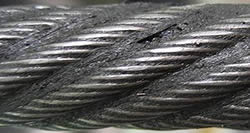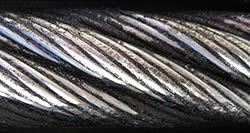Wire Rope - Lay and Construction
Lay of Wire Rope
The lay of a wire rope describes the manner in which either the wires in a strand, or the strands in the rope, are laid in a helix.
Left and right hand lay

Left-hand ordinary lay (LHOL) wire rope (close-up). Right-hand lay strands are laid into a left-hand lay rope.
|

Right-hand Lang's lay (RHLL) wire rope (close-up). Right-hand lay strands are laid into a right-hand lay rope.
|
Left hand lay or right hand lay describe the manner in which the strands are laid to form the rope. To determine the lay of strands in the rope, a viewer looks at the rope as it points away from them. If the strands appear to turn in a clockwise direction, or like a right-hand thread, as the strands progress away from the viewer, the rope has a right hand lay. The picture of steel wire rope on this page shows a rope with right hand lay. If the strands appear to turn in an anti-clockwise direction, or like a left-hand thread, as the strands progress away from the viewer, the rope has a left hand lay. (The rope in the left hand lay photo shows one left hand lay rope from left to right and top to bottom, with 5 right hand lay strands, and part of a sixth in the upper left. It is not 5 right hand lay ropes adjacent to each other.)
Ordinary, Lang's and alternate lay
Ordinary and Ducay's lay describe the manner in which the wires are laid to form a strand of the wire rope. To determine which has been used, first identify if left or right hand lay has been used to make the rope. Then identify if a right or left hand lay has been used to twist the wires in each strand. (On ordinary lay, the outer wires approximately follow the alignment of the rope: with Lang's lay they are cross at an angle of about 45°.) Lang's laid rope is able to flex over sheaves more easily (with less damage) but it has the disadvantage of having a high torque tendency (it tends to untwist when tension load is applied) compared with ordinary laid rope. Untwisting can be dangerous with a steel-cored rope: load is shed from the strands and may cause the core to fail as it becomes higher loaded. For this reason, swivel termination units can be dangerous.
| Ordinary lay |
The lay of wires in each strand is in the opposite direction to the lay of the strands that form the wire. |
| Lang's lay |
The lay of wires in each strand is in the same direction as the lay of the strands that form the wire. |
| Alternate lay |
Strands alternate between Lang's lay and ordinary lay; e.g.: in a 6-strand wire, 3 strands are ordinary lay, and 3 are Lang's lay. |
| Regular lay |
Alternate term for ordinary lay. |
| Albert's lay |
Archaic term for Lang's lay. |
| Reverse lay |
Alternate term for alternate lay. |
| Spring lay |
This is not a term used to classify a lay as defined in this section. It refers to a specific construction type of wire rope. |
Construction and specification
The specification of a wire rope type – including the number of wires per strand, the number of strands, and the lay of the rope – is documented using a commonly accepted coding system, consisting of a number of abbreviations.
This is easily demonstrated with a simple example. The rope shown in the figure "Wire rope construction" is designated thus: 6x19 FC RH OL FSWR

Wire rope construction
|
| 6 |
Number of strands that make up the rope |
| 19 |
Number of wires that make up each strand |
| FC |
Fibre core |
| RH |
Right hand lay |
| OL |
Ordinary lay |
| GSWR |
Galvanized Steel Wire Rope |
| FSWR |
Flexible steel wire rope |
|
